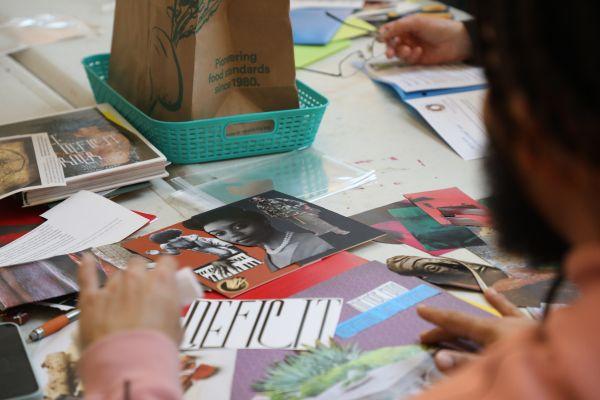Collage as a Window into the Soul

While collage can serve as an excellent creative outlet for any artistic skill level, SoulCollage® facilitator MJ Abell believes it can reveal much more about ourselves than we may think.
On Saturday, January 27, Urban Arts Space hosted a SoulCollage workshop as part of the gallery’s free monthly Artist Commune event, where artists come together to create art and connect with each other. This month’s Artist Commune was held in collaboration with artist and Ohio State MFA candidate Nico Lawson as part of their interactive installation and performance, Grieving Landscapes. The artworks and associated performances commemorate the loss of self that many marginalized people must endure to survive.
With the Grieving Landscapes installation, viewers were invited to explore their own grief by interweaving pieces of yarn, or “lifelines,” into the ever-growing webs throughout the gallery. These lifelines served to trace the souls that have visited the space, both in the exhibition and in our own lives. In the SoulCollage workshop, we focused on reflecting on our own experiences with grief, loss, and disappointment.

I haven’t made a collage in a while, so I was excited to revisit the medium. The workshop began with an open opportunity for participants to walk around, view the gallery, and sift through the many cutouts laid out on tables—these images ranged from magazine cutouts and scrapbook paper to calendar pages and books. MJ said she receives many of the magazines and books from a friend who knows what she typically looks for, as well as Half Price Books.
So what even is a SoulCollage? As the leader of the workshop, MJ Abell believes it’s an opportunity for personal growth and expression. The purpose isn’t to plan out every detail to perfection or demonstrate technical skill—instead, you let the collage create itself with images you’re drawn to, and let the message emerge on its own. When you’re finished, you can let the card speak to you. You can ask it who it is, what it wants you to know, what it needs from you, and any other wisdom you desire.

While there aren’t necessarily “rules” for a SoulCollage, there are guiding principles that can help the artist on their journey, as shared on the SoulCollage website:
- Trust the process!
- Everyone is an artist.
- All ways are the right way. The way that works for you is the right way.
- You are always free to go as deep as you want with the process.
- You have all the answers inside you.
- Each part has something of value to share.
- Describe and reflect what you see and hear, let go of analyzing, evaluating, or giving advice. Practice co-creating an advice-free zone.
- We let our cards be made solely for the purpose of growth and aliveness. We don’t sell, trade, or barter our SoulCollage® cards once they are created.
- What is shared in the room stays in our hearts.
Note: Although not officially stated in the guidelines, MJ claims that Seena Frost, the original creator of SoulCollage, insists that the collage practice goes very well with dark chocolate.
After explaining what a SoulCollage process looks like, we were released to begin our collages. I found myself choosing cutouts for many different reasons—some I saw a specific idea in, some were related to interests of mine, and others I just thought looked cool. I overheard someone ask a regular participant about her experience with SoulCollage, and she said it can be amazing to see what you can express once you put your cards together.

What I found most interesting about the SoulCollage process is how it’s all intuitive and retroactive, and focuses on what the art is communicating to you, rather than what you want it to communicate to others. It was a good exercise to reflect on ideas, events, and experiences, and an opportunity to process your emotions and become at peace with your subconscious thoughts.
At the end, we debriefed as a group and shared how we were feeling about our collages. Many participants reported feeling peaceful, reflective, and relaxed (I, personally, felt very overwhelmed, as I had to rush to finish mine towards the end). We each talked about our pieces, and while I can’t say much, as we agreed to create a confidential environment, I noticed that no two people were grieving over the same thing.
Overall, I really enjoyed the workshop, and I genuinely feel like it re-sparked my interest in collage. It was nice to have a prompt where I didn’t have to stress over skill, technique, or composition—I could simply let the piece breathe itself into life. As MJ Abell shared, SoulCollage provides a great opportunity to “honor parts of your unique life story, to work with an image that resonates with you, and to seek clarity, healing, change, and self-understanding.”


